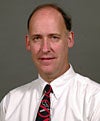
Rembold, Christopher M.
Primary Appointment
Clinician Physician RET, Medicine: Cardiovascular Medicine
Contact Information
PO Box 801395
MR-4 Bldg
Telephone: 434-924-2825
Email: cr2g@virginia.edu
Research Disciplines
Physiology, Translational Science
Research Interests
Hypertension, Dyslipidemia, Insulin resistance, Sleep apnea, Statistical analysis, Smooth Muscle Contraction/Relaxation, Nitric Oxide
Research Description
1) Activation of blood vessel smooth muscle primarily involves pathways which increase calcium and myosin phosphorylation resulting in contraction. Most recently my laboratory has been interested in contractile mechanisms beyond calcium and myosin phosphorylation. Specifically, we found that the sustained phase of contraction was associated with stimulated actin polymerization. Prior increases in stimulated actin polymerization appear to increase the initial phase of subsequent contraction, a process we term force augmentation. We are studying the biochemical determinants of stimulated actin polymerization (paxillin and cofilin phosphorylation) and the biophysical sequelae of stimulated actin polymerization (changes in rheology such as noise temperature). Publications include:
Rembold, C.M. Force suppression and the crossbridge cycle in swine carotid artery. American Journal of Physiology Cell Physiology, 293:1003-1009, 2007.
Rembold, C.M., Tejani, A,D. Ripley, M.L., Han, S. Paxillin phosphorylation, actin polymerization, noise temperature, and the sustained phase of swine carotid artery contraction. American Journal of Physiology Cell Physiology, 293:993-1002, 2007.
Tejani, A.D., Rembold, C.M. Force augmentation and stimulated actin polymerization in swine carotid artery. American Journal of Physiology, in press, 2010.
Relaxation is typically thought to be the reversal of activation, i.e. deactivation, which is caused by a reduction in myosin phosphorylation. There is also a novel form of smooth muscle relaxation that does not involve deactivation mechanisms. Dr. Rembold's group found that elevations in cyclic nucleotides such as cGMP and cAMP can reduce smooth muscle contraction despite elevated myosin phosphorylation. This process was termed force suppression. Dr. Rembold's laboratory has concentrated on the mechanism responsible for force suppression. His group and others found that cyclic nucleotide-induced relaxation was associated with phosphorylation of a small heat shock protein 20 known as HSP20 or P20. His group also found that HSP20 phosphorylation was shown to specifically correlate with force suppression rather than the deactivation form of relaxation. A peptide of HSP20 was noted to have sequence homology with troponin I, the main regulatory protein in skeletal and cardiac muscle. The Peptide from this homology region bound thin filaments, reduced myosin ATPase activity, and relaxed skinned swine carotid artery. We are currently testing the hypothesis that binding of phosphorylated HSP20 to the smooth muscle thin filaments may turn off thin filaments so that phosphorylated myosin does not interact with the thin filament (i.e. a model similar to skeletal muscle troponin I). Publications include:
Rembold C.M., Foster, B., Strauss, J., Wingard, C., Van Eyk, J.E. cGMP mediated phosphorylation of heat shock protein 20 may cause smooth muscle relaxation without myosin light chain dephosphorylation. Journal of Physiology (London), 524:865-878, 2000.
Meeks, M., Ripley, M., Jin, Z. Rembold C.M., Heat shock protein 20 mediated force suppression in forskolin relaxed swine carotid artery. Am J Physiology Cell Physiology, 288:C633-C639, 2005.
3) I also study sleep apnea in children. Publications include:
Suratt, P.M., Barth, J.T., Diamond, R., D’Andrea, L., Nikova, M., Periello, V.A., Carskadon, M.A., Rembold, C.M. Reduced Time in Bed and Obstructive Sleep Disordered Breathing in Children are Associated with Cognitive Impairment. Pediatrics, 119:320-329, 2007.
4) Finally, I also study the use of carotid intimal medial thickness in the detection of preclinical atherosclerosis. Publications include:
Stein, J.H., Korcatz, C.E., Hurst, R.T., Lonn, E., Kendall, C.B., Mohler, E.R., Naijar, S.S. Rembold, C.M., Post, W.S. Use of carotid ultrasound to identify subclinical vascular disease and evaluate cardiovascular disease risk: A consensus statement from the American society of echocardiography carotid intima-media thickness task force endorsed by the society for vascular medicine. Journal of the American Society of Echocardiography, 21:93-111, 2008.
